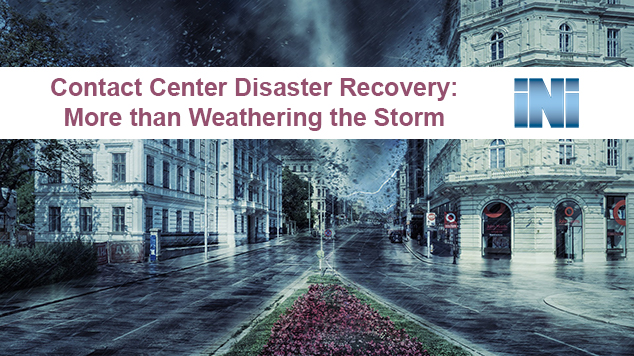 by Glen Taylor & Kyle Henderson
by Glen Taylor & Kyle Henderson
With all of the recent hurricanes, wildfires, and other natural disasters impacting countless people and organizations—and our thoughts are with all those affected—we want to re-visit what enterprises can do to plan for disasters and, to the extent possible, maintain business-as-usual for their customers and constituents. I sat down with long-time disaster recovery consultant and INI solutions architect Glen Taylor to discuss.
Of course, at INI we believe people drive success and are any organization’s most valuable asset. Health, safety and wellbeing should always come first, but for the purposes of this article we’re going to focus on the contact center and IVR systems.
Kyle Henderson (KH): What is Disaster Recovery for the contact center and IVR?
Glen Taylor (GT): Disaster Recovery (DR) planning is like insurance; you’re paying someone to think about an event you don’t expect to happen, just in case. You have to make your best guess on what you’ll need and hope you never have to use it. There are multiple aspects to a DR plan, and telecom and IVR systems are usually important pieces of that plan. But before any plan can be made, the DR team must first determine and assess issues such as:
-
- What kind of natural disasters is the geographical area prone to?
- What elements of the organization are most critical to preserve?
- What is the impact of each kind of issue on the business, customer access, customer experience etc.?
- What is the financial cost/benefit tradeoff?
As an example, if power gets knocked out to your data center, taking down your IVR platform, is that an event you must respond to? The DR team must assess; preferably before disaster strikes. They may decide even though an important function is missing, the rest of your business can pick up the slack with agents fielding every call. Conversely, they may determine the IVR is too essential a component to go without, due to lost revenue if the IVR pay-by-phone application went down. This impact assessment will directly drive the DR plan.
KH: How does redundancy fit in Disaster Recovery for IVR?
GT: If the DR planning team determines that maintaining the IVR platform is important to the business, they must also evaluate the value of multiple applications. Callback, intelligent routing, outbound messaging, and customer satisfaction surveys are all different applications with different levels of importance. The IVR platform and the critical applications may need to be fully replicated. Most people intuitively think of DR as full duplication, or a full backup, but it isn’t necessary for less-critical functions that the organization can scale back or deems non-essential.
For example, an enterprise may have an IVR application that identifies callers and then routes them to agents producing a screen pop. If the IVR is gone, then agents will still get the calls but they won’t have the screen pop information. The DR team may judge such functionality as something the enterprise can live without for a period of time, in which case no redundancy for that particular IVR application may be required.
 KH: How important is it to have multiple geographical sites?
KH: How important is it to have multiple geographical sites?
GT: Distributed geography is usually considered the key to most DR planning. Ideally, an enterprise would diversify its infrastructure so that agents, IVR resources, and IVR applications are operational at more than one site so that a disaster in one location would not simultaneously impact another location.
The best DR is to operate multiple production sites with complete systems so that they could handle the whole load if one site goes down. Even if the capacity of the other site(s) is not 100 percent of need, it may provide the 70 percent or 80 percent that is judged to be sufficient.
KH: How do self-service systems fit in Disaster Recovery plans?
GT: Many disaster situations will have as much or more impact on agents (people resources) than on the IVR (data center resources). In the cases where agents may be affected more than the IVR platform, self-service and voice applications specifically for DR may be useful.
If callers are going to experience longer hold times to get to a reduced agent staff, applications that announce to callers the nature of the disaster and how it will affect agent availability are useful. Callback applications like INI SureConnect become more important. Even form-fill applications like INI AudioForms(now INI FormStudio), which can collect detailed information from a caller and provide the promise that the enterprise will respond to the information with follow-up, can improve the caller experience during periods of disaster.
KH: How is High Availability different than Disaster Recovery?
GT: High Availability (HA) is concerned with the failure of one or more components of a solution such as servers, operating systems, applications, databases, etc. at one site. Most architectures have one or more components whose failure could render the entire system (an IVR system, for example) unusable. Really, only the very least mission-critical components of a system should have this “single point of failure” approach. HA is created by adding one or more instances of critical components to share the load if a single component fails. Even with an HA approach, component failure will still result in a reduction in total capacity, but that may meet enterprise objectives.
DR planning is distinct from HA planning. Although making a primary or single production site HA is almost a given, the question then becomes how much HA does a DR site need? Again, these are cost/benefit trade-offs. If a DR site is an active-active production site—meaning it’s always in use—it will almost certainly be HA, probably with sufficient total capacity to handle its peak busy hour volume and all of a failed site’s traffic in a disaster. If an enterprise is putting in a DR site that will only be active during a disaster, it may choose to omit HA from that site as it would likely be used rarely and only temporarily. Providing for normal traffic in this DR site but without HA may be a risk the enterprise is willing to take, but it’s not recommended.
KH: Both HA and DR are essential facets to ensure an organization continues moving forward as much as possible when faced with nature’s least desirable events. Disaster Recovery planning that accounts for IVR with redundant systems and multiple sites not only helps avoid negative outcomes such as lost revenue, but it can also ensure—even in the most challenging circumstances—that customer experience doesn’t drop below lofty expectations and damage credibility.
